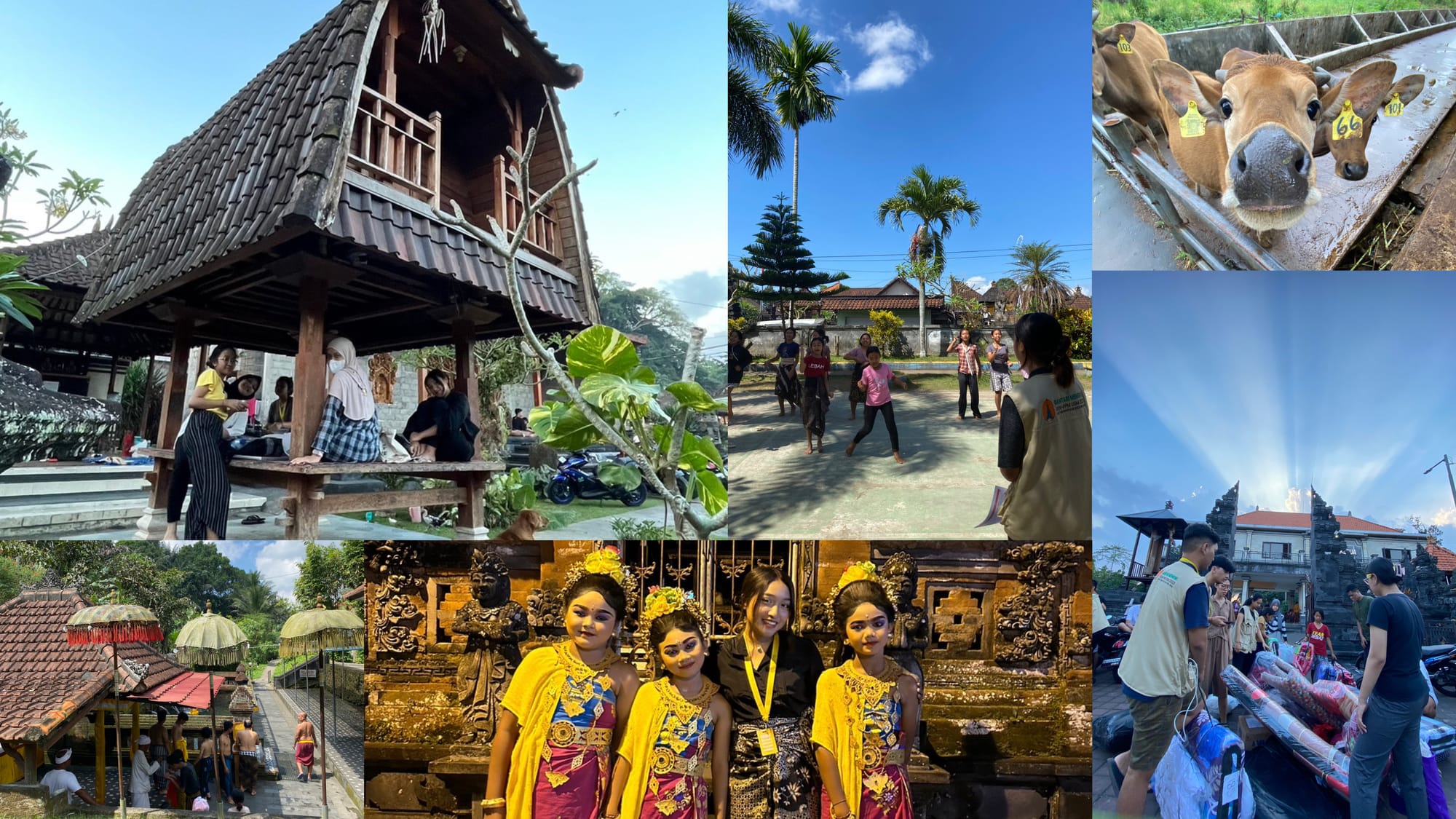Bridging Gaps and Embracing Culture: My Time in Sobangan Village, Bali

Kuliah Kerja Nyata (KKN): A Real-World Learning Experience
The Kuliah Kerja Nyata (KKN) program is a mandatory social service initiative for students at Gadjah Mada University, designed to bridge the gap between academic knowledge and real-world applications. The program places students in rural villages across Indonesia, where they live and work in teams made up of students from different faculties and majors. The goal is to apply what we've learned in school to help solve local challenges while immersing ourselves in the community.

Sobangan and Baha Village: A Hidden Gem in Bali
During my time in the Kuliah Kerja Nyata (KKN) program, our team was placed at Baha and Sobangan village. Located in the Mengwi District of Badung, Bali, Sobangan is a village that truly reflects the essence of Balinese life. Known for its marigold flower fields—used daily for prayers—Sobangan is also home to the largest Bali cow farm in the region. On top of that, the village boasts stunning waterfalls, a natural spring pool, and even a hero monument, making it a prime spot for domestic tourism. The landscape is lush, and the local Hindu customs are deeply intertwined with daily life. I couldn’t have asked for a better place to experience the culture and the beauty of Bali.
Our team worked on several projects aimed at benefiting both Baha and Sobangan villages. As a diverse group of students from different faculties, we tackled key areas to help the locals and boost tourism. Our projects included mapping recreational sites to enhance tourism potential, bookkeeping for farmers and livestock producers to streamline distribution, and educational programs focused on sustainability and community empowerment. We also organized workshops on mushroom cultivation to diversify income sources. To engage the community and attract visitors, we held three major events: Festival Hari Anak (Children’s Day Festival) and art performances in both villages, showcasing local talent and fostering unity.
My Personal Projects: Bringing Innovation to the Village
In addition to working on team projects, I also took on a few personal projects that allowed me to dive deeper into the village’s potential, particularly in the tourism sector:
- Mapping & creating capacity building programs for artists for tourism development
- Anti-bullying campaign for elementary school and junior high school kids
- Sobangan Village Tourism Guide
The People and Their Routine
During our time there, we lived in a house with our host family (and their three cute dogs). The people of Bali are some of the warmest people I’ve ever met. They are both laid-back and lively, with a genuine sense of community that makes you feel right at home.The people here live a very specific way of life, with Hinduism norms deeply ingrained in their daily routines. Another thing that I love is the people's deep appreciation towards art. People here can either sing, carve wood into beautiful ornaments, dance, or all of the above.
Days start early, as most people in the village are farmers. Every morning, around six, I’m greeted by the sight of Pak Man, with a garden broom in his hand and a light serenade. He sure loves to sing. By the time we get out of our room, Ibu Dewi is usually already halfway through her morning prayers, carefully placing canang (offerings) on different areas of the house. Let's not forget her colorful scarves, in the brightest shades of purple or yellow. Sometimes, I’m surprised to find a group of gentlemen already sipping their coffee and reading the local newspapers at six.
"Pagi, gek"
"Ngopi, gek"
"Gek udah bangun?"
It’s a bit embarrassing, how they've already gotten started on their day while I’m still trying to gather my soul. The pace slows down by the afternoon. The markets begin to empty, and the house remains silent and serene during that time—a perfect moment for some alone time. When the clock strikes 12, Gus Teja never fails to fill the emptiness in the air with his iconic song 'Beauty in Colors.' I’ve been told it’s prohibited to leave your house or mobilize at 12 o’clock sharp. At night, after 10 PM, the gentlemen begin coming to our house. They talk, play mahjong, sing, and drink tuak (palm wine), arak, or mostly Bali Craft Beer. You’ll often find roasted peanuts as a snack. This activity continues until around 1 or 2 AM. This habit of 'meceki' would be considered taboo in other regions, but I found that it actually helps bond the community of gents together.
The Beauty of Balinese Traditions : Galungan Day
The Balinese always find reasons to celebrate, and they’re not shy about spending millions on their festivities. We were fortunate enough to be in Sobangan for the second Galungan of the year. Galungan is Bali’s version of Christmas or Eid—stores typically close a few days before and after, and families travel to visit relatives. Since most of the people in Sobangan are from other regions, the village becomes quite empty during this time (finding an open laundry place was a bit of a challenge).

Preparations for Galungan began the minute we set foot in the village. By noon, the women of the house were busy making small, round rice cakes in large batches by hand. These rice puffs were dried in refrigerator-like drawers and sold to small cooperatives. One time, I went to Baha Village for a full-team coordination meeting and was delighted by the sight of women in beautiful, colorful kabayas. Everyone had a specific role, and we were making small banten (offerings). I joined one of the groups along with my friends, and we worked with flowers such as pacar air (blue flowers), yellow-ish green shrubs, and bright yellow marigolds. I made three types of banten: one resembling a square using fresh leaves, and two made from dried leaves (one tiered, the other shaped like a leaf).
Leading up to Galungan, people set up beautiful, towering penjor (decorative bamboo poles), which were often used to display wealth. As a girl from a big city in Java, I was in awe of how festive the streets looked. Much like a typical Eid morning, everyone gets up super early—women put on their most beautiful white kabayas, colorful scarves, have their hair done, and their faces made up. The men wear traditional Balinese clothing, including udeng (headgear). Families gather at the pura (temple) for morning prayers, while a group of Barong dancers and a priest bless the canang placed in front of homes. The children roam the streets playing the character of Barong, taking turns with the head and tail of the costume. They perform for money, but it keeps the culture alive.
Pak Man even called one of the Barong groups to perform in our yard. While the Balinese are used to this, it was a super cool experience for me.
Having a Barong dance in our yard? When would I get another chance to experience that?
The Balinese take their Galungan preparations seriously. Beautiful fruits were presented on tiered platters, so much so that we were left with piles for the following week—more than we could consume. I tried to carry one of the platters on my head, and just two minutes in, I could feel my neck cramping. I have nothing but respect for the women who carry these heavy platters for miles. All in all, I made a conscious effort to be present in the moment and absorb as much as I could.
How This Experience Shaped My Perspective
During my time in Sobangan, I learned the immense value of community collaboration and how diverse skill sets can come together to create meaningful change. Working on projects that directly impacted the village allowed me to see firsthand the power of applied knowledge. I discovered how crucial sustainable practices are in rural development and how even small-scale initiatives can drive long-term progress.

One last thing that I have to note is how my eyes are forced to be open to the disparity in education across Indonesia. I had the privilege of seeing it firsthand —especially as I visited the local schools and engaged with both students and teachers. While some areas are well-equipped and thriving, others, like Sobangan, still face challenges in terms of resources and access to quality learning. What's saddening is how excited the kids are in learning and embracing new methods of studying in-class. This experience emphasized the need for education as a tool for change, empowerment, and bridging the gap between rural and urban areas.
The 1,300 words I've written is not merely enough to tell you the impact that this program gave me. I am deeply thankful for all of the people that were in this journey with me : my friends/team, our host family, and the whole people of Sobangan and Baha Village.
This site is powered by Kambium, the product of Kugie App.




